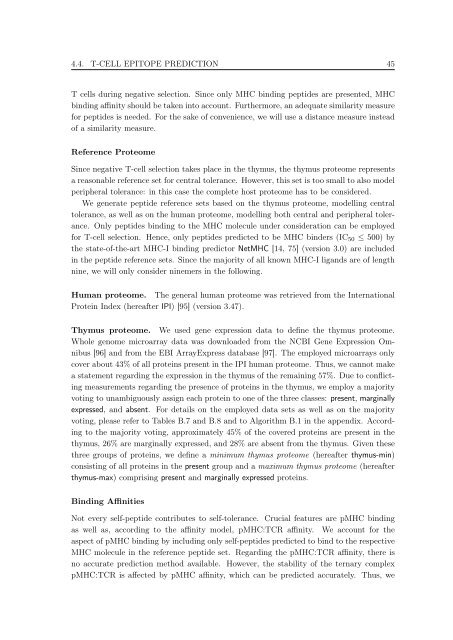New Approaches to in silico Design of Epitope-Based Vaccines
New Approaches to in silico Design of Epitope-Based Vaccines
New Approaches to in silico Design of Epitope-Based Vaccines
You also want an ePaper? Increase the reach of your titles
YUMPU automatically turns print PDFs into web optimized ePapers that Google loves.
4.4. T-CELL EPITOPE PREDICTION 45<br />
T cells dur<strong>in</strong>g negative selection. S<strong>in</strong>ce only MHC b<strong>in</strong>d<strong>in</strong>g peptides are presented, MHC<br />
b<strong>in</strong>d<strong>in</strong>g aff<strong>in</strong>ity should be taken <strong>in</strong><strong>to</strong> account. Furthermore, an adequate similarity measure<br />
for peptides is needed. For the sake <strong>of</strong> convenience, we will use a distance measure <strong>in</strong>stead<br />
<strong>of</strong> a similarity measure.<br />
Reference Proteome<br />
S<strong>in</strong>ce negative T-cell selection takes place <strong>in</strong> the thymus, the thymus proteome represents<br />
a reasonable reference set for central <strong>to</strong>lerance. However, this set is <strong>to</strong>o small <strong>to</strong> also model<br />
peripheral <strong>to</strong>lerance: <strong>in</strong> this case the complete host proteome has <strong>to</strong> be considered.<br />
We generate peptide reference sets based on the thymus proteome, modell<strong>in</strong>g central<br />
<strong>to</strong>lerance, as well as on the human proteome, modell<strong>in</strong>g both central and peripheral <strong>to</strong>lerance.<br />
Only peptides b<strong>in</strong>d<strong>in</strong>g <strong>to</strong> the MHC molecule under consideration can be employed<br />
for T-cell selection. Hence, only peptides predicted <strong>to</strong> be MHC b<strong>in</strong>ders (IC50 ≤ 500) by<br />
the state-<strong>of</strong>-the-art MHC-I b<strong>in</strong>d<strong>in</strong>g predic<strong>to</strong>r NetMHC [14, 75] (version 3.0) are <strong>in</strong>cluded<br />
<strong>in</strong> the peptide reference sets. S<strong>in</strong>ce the majority <strong>of</strong> all known MHC-I ligands are <strong>of</strong> length<br />
n<strong>in</strong>e, we will only consider n<strong>in</strong>emers <strong>in</strong> the follow<strong>in</strong>g.<br />
Human proteome. The general human proteome was retrieved from the International<br />
Prote<strong>in</strong> Index (hereafter IPI) [95] (version 3.47).<br />
Thymus proteome. We used gene expression data <strong>to</strong> def<strong>in</strong>e the thymus proteome.<br />
Whole genome microarray data was downloaded from the NCBI Gene Expression Omnibus<br />
[96] and from the EBI ArrayExpress database [97]. The employed microarrays only<br />
cover about 43% <strong>of</strong> all prote<strong>in</strong>s present <strong>in</strong> the IPI human proteome. Thus, we cannot make<br />
a statement regard<strong>in</strong>g the expression <strong>in</strong> the thymus <strong>of</strong> the rema<strong>in</strong><strong>in</strong>g 57%. Due <strong>to</strong> conflict<strong>in</strong>g<br />
measurements regard<strong>in</strong>g the presence <strong>of</strong> prote<strong>in</strong>s <strong>in</strong> the thymus, we employ a majority<br />
vot<strong>in</strong>g <strong>to</strong> unambiguously assign each prote<strong>in</strong> <strong>to</strong> one <strong>of</strong> the three classes: present, marg<strong>in</strong>ally<br />
expressed, and absent. For details on the employed data sets as well as on the majority<br />
vot<strong>in</strong>g, please refer <strong>to</strong> Tables B.7 and B.8 and <strong>to</strong> Algorithm B.1 <strong>in</strong> the appendix. Accord<strong>in</strong>g<br />
<strong>to</strong> the majority vot<strong>in</strong>g, approximately 45% <strong>of</strong> the covered prote<strong>in</strong>s are present <strong>in</strong> the<br />
thymus, 26% are marg<strong>in</strong>ally expressed, and 28% are absent from the thymus. Given these<br />
three groups <strong>of</strong> prote<strong>in</strong>s, we def<strong>in</strong>e a m<strong>in</strong>imum thymus proteome (hereafter thymus-m<strong>in</strong>)<br />
consist<strong>in</strong>g <strong>of</strong> all prote<strong>in</strong>s <strong>in</strong> the present group and a maximum thymus proteome (hereafter<br />
thymus-max) compris<strong>in</strong>g present and marg<strong>in</strong>ally expressed prote<strong>in</strong>s.<br />
B<strong>in</strong>d<strong>in</strong>g Aff<strong>in</strong>ities<br />
Not every self-peptide contributes <strong>to</strong> self-<strong>to</strong>lerance. Crucial features are pMHC b<strong>in</strong>d<strong>in</strong>g<br />
as well as, accord<strong>in</strong>g <strong>to</strong> the aff<strong>in</strong>ity model, pMHC:TCR aff<strong>in</strong>ity. We account for the<br />
aspect <strong>of</strong> pMHC b<strong>in</strong>d<strong>in</strong>g by <strong>in</strong>clud<strong>in</strong>g only self-peptides predicted <strong>to</strong> b<strong>in</strong>d <strong>to</strong> the respective<br />
MHC molecule <strong>in</strong> the reference peptide set. Regard<strong>in</strong>g the pMHC:TCR aff<strong>in</strong>ity, there is<br />
no accurate prediction method available. However, the stability <strong>of</strong> the ternary complex<br />
pMHC:TCR is affected by pMHC aff<strong>in</strong>ity, which can be predicted accurately. Thus, we

















